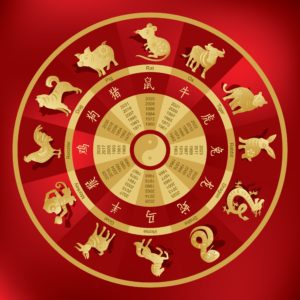
Most people in our culture already know about the Western zodiac system based on Greek and Babylonian astrological traditions. However, many Americans today have become more familiar with the Chinese zodiac and its 12-year system featuring creatures from Chinese mythology. There are several key differences between the Western and Chinese versions, and the latter exhibits some vital aspects of mainstream Chinese culture.
A 12-Year Cycle With Lunisolar Years
Unlike the Western zodiac, the Chinese system doesn’t use constellations visible in Earth’s night skies. Rather, it’s a 12-year cycle in which each year is represented by a significant animal or mythological figure from Chinese culture. This schema was derived from an agricultural lunisolar Chinese calendar known as “yingyang li.” The Encyclopedia Britannica reveals how this calendar developed over time as Chinese astronomers gained more knowledge and attempted to syncretize both a lunar-based and solar system into one format.
Since the Chinese calendar follows a lunisolar schedule, each year usually begins sometime in late January or early February, depending on when the first new moon falls. This movable Lunar New Year date also affects the beginning and ends of each year’s sign. For example, someone with a birthdate of February 1, 1976, would have been born under the Dragon sign. In contrast, a person born on the same date in 1988 would be considered a Rabbit instead.
Zodiac Signs and Mythical Animals
Every year in this zodiac cycle corresponds with an animal or mythological being from Chinese folk legends. Although there are some issues with translation between the Hanzi characters used to write Mandarin Chinese and modern English, most editions of this zodiac list these 12 signs in a specific order:
- Rat or Mouse
- Ox, Cow, or Buffalo
- Tiger
- Rabbit or Hare
- Dragon
- Snake
- Horse
- Goat, Ram, or Sheep
- Monkey
- Rooster or Chicken
- Dog
- Pig or Boar
Notably, the Dragon is the only purely mythological creature used in this schema.
The Legend of the Great Race
In her ThingsAsian article, contributor Audrey Lim discusses one legend explaining the Chinese zodiac’s origins. The Jade Emperor of Heaven held a great race in which 12 winners would be selected, forever determining their positions in the zodiac. Lim first explains that Rat and Cat both jumped onto the Ox’s back to ride, since neither could swim. However, Rat pushed Cat into the water and leaped onto the shore first. As a result, Cat was left out of the zodiac and remains Rat’s enemy to this day. Once Ox had stepped onto the river’s shores, the Tiger emerged after swimming through the water’s powerful currents. Rabbit was next to follow, hopping from stone to stone and hitching a ride on a floating log to reach the shore.
The Emperor was surprised when Dragon came in fifth, but the mighty creature had been delayed when he stopped to help bring down rain to water the land and send Rabbit across to shore with a puff from his snout to Rabbit’s floating log. Next came Snake, who had frightened Horse into falling behind him. Sheep, Monkey, and Rooster placed after Horse in the next three spots through cooperation, with Rooster grabbing a raft and Monkey and Sheep clearing weeds as they pulled it across. Dog and Pig finished in the last two places because Dog was tempted to bathe in the river and Pig stopped to eat along the way.
The Interplay Between a Culture and Its Stories
Humans forever strive to understand the world and how it works, and many of their explanations make it into cultural myths and traditions. Whatever your views are concerning astrology, studying its various classification systems provide some fascinating revelations. Whether it’s the Western, Chinese, Hindu, or other versions you examine, you’re bound to discover some fascinating stories.

